To smoke meat with natural wood, you'll need to start with quality hardwoods like hickory, oak, or fruitwoods while avoiding softwoods like pine or cedar. Select wood with about 20% moisture content and guarantee it's free from mold or rot. Maintain your smoker's temperature between 220-250°F by managing airflow through the vents, and aim for thin blue smoke, which indicates ideal smoking conditions. Add wood early in the cooking process while the meat is cool for better smoke absorption, and use a dual-probe thermometer to monitor both smoker and meat temperatures. Master these fundamentals, and you'll reveal the secrets to perfectly smoked meats.
Understanding Wood Types for Smoking
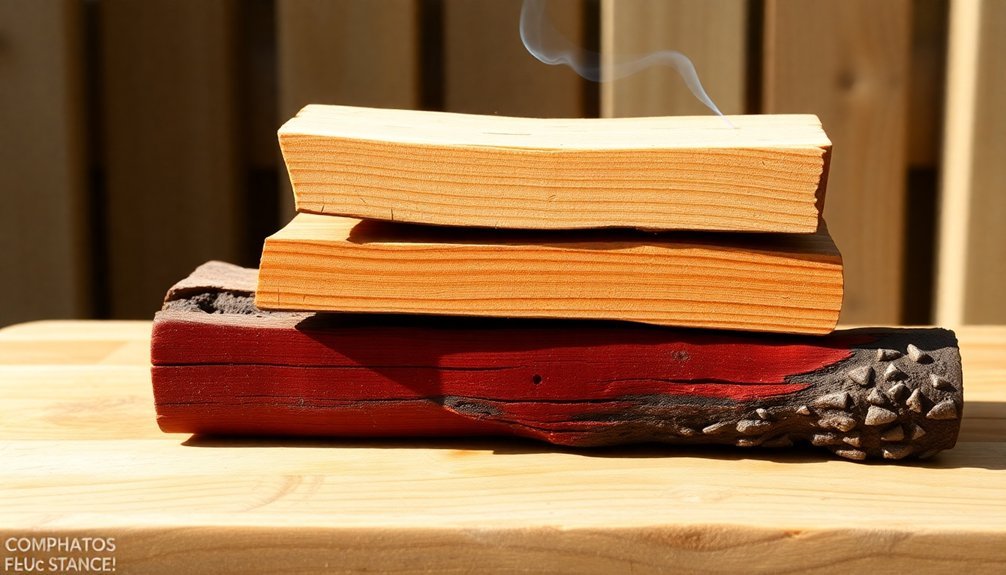
When it comes to smoking meat, selecting the right wood type is essential for achieving your desired flavor profile. Hardwoods like hickory and oak form the foundation of traditional smoking, with hickory offering a stronger flavor that's perfect for pork and chicken, while oak provides a milder, even burn ideal for brisket and ribs. For optimal results, using logs and chunks will provide significantly longer burn times compared to other forms of wood.
If you're looking for sweeter notes, consider maple or pecan. Maple imparts a mild sweet undertone that works beautifully with bacon and ham, while pecan delivers a stronger smoky-sweet flavor similar to hickory.
For those who prefer fruit woods, apple and cherry provide gentle, fruity notes that complement poultry and pork without overpowering the meat.
You'll want to avoid softwoods like cedar and pine, as they can produce sooty smoke and potentially harmful compounds. Instead, stick to proven options like alder for seafood or mesquite for beef.
The form of wood you choose matters too – logs and chunks last longer for traditional BBQ, while chips work better for shorter cooks. Remember that wood with some moisture content burns slower, making it ideal for low and slow cooking techniques.
Proper Wood Selection Process
Before diving into meat smoking, selecting the proper wood requires careful consideration of several key factors. You'll want to start by choosing hardwoods over softwoods, as softwoods like pine and cedar produce toxic, resinous smoke that can ruin your meat and pose health risks. Instead, opt for proven hardwoods like hickory, oak, or fruit woods that deliver clean, flavorful smoke. Starting with just one chunk of wood is recommended to avoid overwhelming the meat with smoke.
- Check the wood's moisture content – aim for around 20% moisture level. You don't want wood that's too green or waterlogged, as it'll produce inconsistent smoke and affect cooking temperatures.
- Choose the right size format based on your cooking duration – chips for quick smokes, chunks for medium sessions, and logs for extended cooking times.
- Match wood type to your meat – use mild woods like apple or cherry for poultry and fish, medium-strength woods like oak for pork, and strong woods like mesquite for beef and game.
- Inspect wood quality carefully – avoid pieces that show signs of rot, mold, or excessive moisture. Look for clean, dry wood with no powdery residue.
Consider combining different woods to create unique flavor profiles, such as mixing hickory's boldness with cherry's sweetness.
Smoking Equipment and Tools
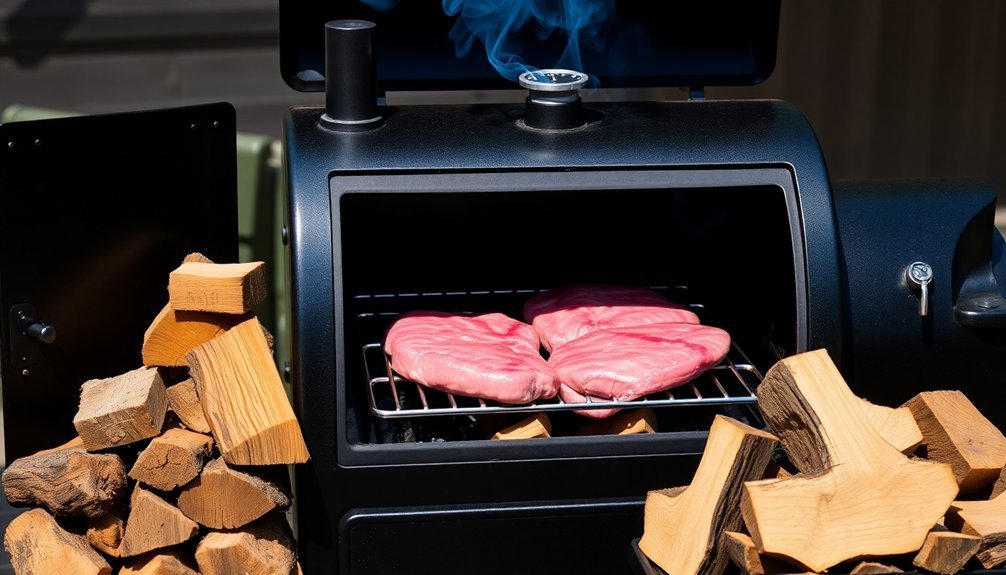
Successful meat smoking requires the right equipment and tools to achieve consistent, flavorful results. You'll need a reliable smoker, with options including wood smokers that use split logs, pellet smokers with electric augers, gas smokers powered by propane, or electric smokers with auto-feed systems.
Your essential tools should include dual-probe thermometers to monitor both smoker and meat temperatures. A wireless thermometer, like the Thermoworks Smoke, lets you track temperatures remotely.
You'll also need sturdy BBQ tongs with non-slip grips, heat-resistant gloves, and a heavy-duty spatula for handling meats. A 12-inch smoke tube can add extra flavor when converting any standard grill into a smoker.
Don't forget cleaning and preparation tools. A BBQ grill brush keeps your cooking area clean, while a proper slicing knife and boning knife help with meat prep and serving. For specific cuts like pulled pork, bear claws or sturdy forks make shredding easier.
Consider accessories that enhance your smoking experience. A water pan helps regulate temperature and humidity, while proper ventilation guarantees steady smoke flow.
For organization, look for tool sets with storage solutions to keep your equipment readily accessible.
Fire Management and Temperature Control
Building your initial heat base requires starting with smaller wood pieces in the firebox and gradually adding larger pieces once the coals are established.
You'll need to control the smoke quality by monitoring its color, aiming for blueish or clear smoke while avoiding thick white smoke that can make your meat taste bitter.
Setting up distinct temperature zones in your smoker comes down to managing airflow through the vents and maintaining a steady temperature between 220-250°F using your thermometer as a guide.
Building Your Heat Base
At the heart of effective meat smoking lies proper fire management and temperature control. To build a proper heat base, you'll want to start with smaller pieces of wood before graduating to larger logs. Combine charcoal with cooking wood or smoking chunks to maintain better temperature control while adding the desired smoky flavor to your meat.
For ideal results, select hardwoods like oak that burn at a consistent temperature of around 1,110 degrees Fahrenheit. You'll want to keep your cooking temperature between 220-250 degrees Fahrenheit for most meats. Remember to avoid softwoods and strong-flavored hardwoods like mesquite that can overpower your food.
Here's how to maintain your heat base effectively:
- Keep the firebox vent open while partially closing the chimney to regulate temperature.
- Use timber spits roughly 4-7cm thick and 30cm long for the best burning results.
- Monitor temperature changes with a wireless remote thermometer.
- Make vent adjustments gradually, allowing about 15 minutes for changes to take effect.
Remember to keep the smoker's lid closed as much as possible to maintain consistent temperature and smoke flavor. Add wood or charcoal as needed to sustain your target temperature range.
Managing Smoke Quality
The quality of smoke can make or break your smoked meat experience. To achieve the perfect smoke, you'll want to use hardwoods like hickory, oak, or fruitwoods such as apple and cherry.
Never use lighter fluid, as it'll impart chemical flavors to your meat. Watch for thin blue smoke, which signals ideal burning conditions, while thick white smoke indicates poor combustion.
Control your airflow carefully by adjusting the smoker's vents and dampers. Too much airflow will burn your wood too quickly, while insufficient air results in weak smoke flavor.
You'll need to maintain proper ventilation throughout the cooking session and leave adequate space around the meat for smoke circulation.
Monitor your smoke quality by watching the exhaust. You're looking for nearly invisible or slightly blue smoke – that's your sweet spot. If you see white, gray, or black smoke, adjust your fire immediately.
Keep your temperature steady between 220-250°F, using a reliable thermometer. If you notice the meat getting too much smoke exposure, wrap it in butcher paper or foil.
Remember to adjust your fire based on the cooking phase, starting with a smokier fire early on and shifting to a cleaner burn later.
Temperature Zone Control
Successful temperature control starts with proper setup of your smoker's fire zones and heat distribution.
You'll want to preheat your smoker to 250°F before adding any meat, and don't worry about the temporary temperature drop when you load cold meat – it's normal and will stabilize on its own.
Resist the urge to adjust your fire or vents during this initial drop, as this can lead to constant temperature adjustments throughout your cook.
For ideal temperature zone control, follow these essential steps:
- Start your fire with hot coals in the smoker's corner, adding hardwood once they're red hot.
- Maintain a steady coal bed as your primary heat source while monitoring your smokestack.
- Use water pans strategically to help maintain consistent internal temperatures.
- Adjust bottom intake and top exhaust vents to fine-tune your temperature control.
Different cuts require different temperature approaches.
You might need to monitor the flat and point of a brisket separately, or consider increasing temperatures from 225°F to 325°F to push through the stall phase.
Keep your thermometer probes properly placed, avoiding bones and fat seams for accurate readings.
Essential Wood Smoking Techniques
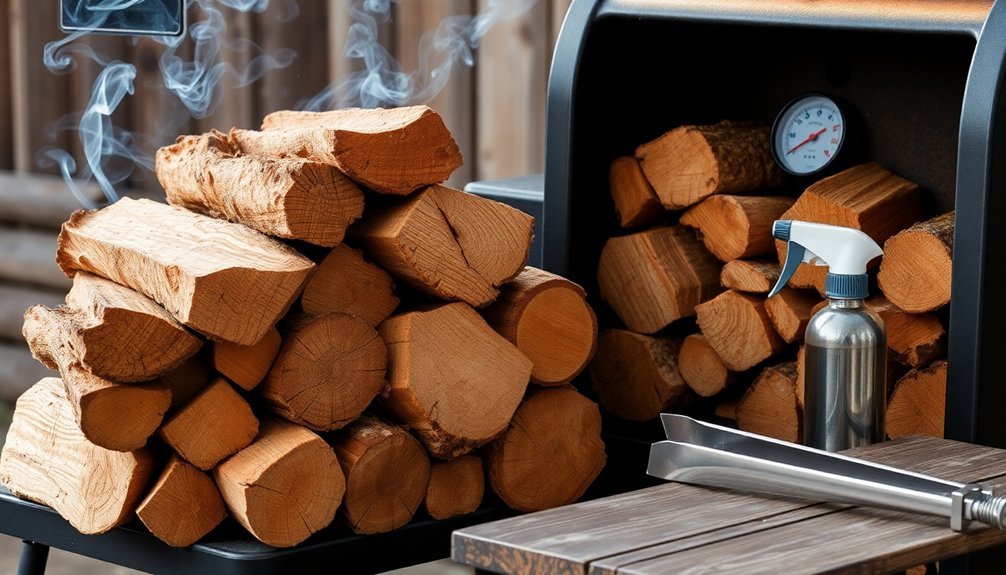
Mastering four essential wood smoking techniques will elevate your meat smoking game from amateur to artisan level.
First, you'll need to select the right wood – stick to hardwoods and avoid softwoods that produce sooty smoke. High-quality hardwood with low sap content will give you the best results and consistent smoke flavor.
Next, prepare your wood properly. Use seasoned, dry wood in the form of chips, chunks, or logs depending on your smoking method. While you can soak chips in water to slow their burn rate, don't waste time with beer or wine soaks – they won't enhance the flavor.
When adding wood to your smoker, wait until it reaches about 200°F, then place the chunks directly on hot coals or bury them in unlit coals for steady smoke production. You'll want a small, hot fire that burns consistently.
Finally, maintain ideal smoking conditions. Keep your smoker around 250°F and use a water pan to maintain humidity.
Add wood early in the cooking process when the meat's still cool – that's when it absorbs smoke flavor best. Guarantee good air circulation around the meat for even smoke penetration.
Wood Flavor Pairing Guide
Understanding wood flavor profiles and their ideal pairings can take your smoked meats from good to extraordinary. When selecting wood for smoking, you'll find three main categories: mild, medium, and heavy woods, each offering distinct characteristics that complement different types of meat.
Mild woods like apple, cherry, and peach provide subtle, fruity notes that won't overpower delicate meats. They're perfect for poultry, fish, and pork.
Medium woods, including oak, hickory, and pecan, deliver a more robust smoke flavor that pairs exceptionally well with red meats and larger cuts.
Heavy woods such as mesquite and walnut create intense, bold flavors that can dominate your meat if not used carefully.
- Start with mild woods for your first few smoking sessions until you're comfortable with smoke management.
- Mix different woods to create unique flavor profiles – try combining cherry with hickory for pork.
- Avoid softwoods like pine or cedar, as they can release harmful chemicals.
- Match your wood intensity to your meat – lighter woods for delicate foods, heavier woods for robust cuts.
Remember to use properly seasoned hardwood and verify it's burning cleanly before adding your meat to the smoker.
Frequently Asked Questions
Can I Reuse Wood Chunks or Chips for Multiple Smoking Sessions?
You can reuse wood chunks if they're not completely burned, but wood chips aren't reusable since they burn quickly to ash. Store your unburned chunks in a dry place for future smoking sessions.
How Long Should I Let Meat Rest After Smoking?
You'll want to rest your smoked meat based on its size. Let brisket rest for an hour, pork butt for 45 minutes, and smaller cuts for 15 minutes. Resting helps retain juices and improves texture.
What's the Best Way to Store Unused Smoking Wood?
Store your smoking wood in a cool, dark, dry place using ventilated containers like cardboard boxes or metal crates. You'll want to avoid plastic, maintain airflow, and keep it away from direct sunlight and moisture.
Should I Rotate Meat Position During the Smoking Process?
Yes, you'll want to rotate your meat halfway through smoking to guarantee even cooking. If you're doing a longer smoke, rotate up to three times, especially when using smaller smokers with uneven heat distribution.
Can Weather Conditions Affect Wood Smoking Performance?
Yes, weather conditions greatly affect your smoking performance. You'll find humidity impacts wood burning efficiency, while cold temperatures challenge temperature control. High humidity also reduces smoke absorption and seasoning penetration into your meat.
In Summary
You've now learned the fundamentals of smoking meat with natural wood, from selecting the right wood types to managing your fire and temperature. Remember to start with mild woods like apple or cherry before moving to stronger flavors like hickory or mesquite. With practice and patience, you'll master the art of wood smoking and create delicious, flavorful meats that'll impress family and friends.

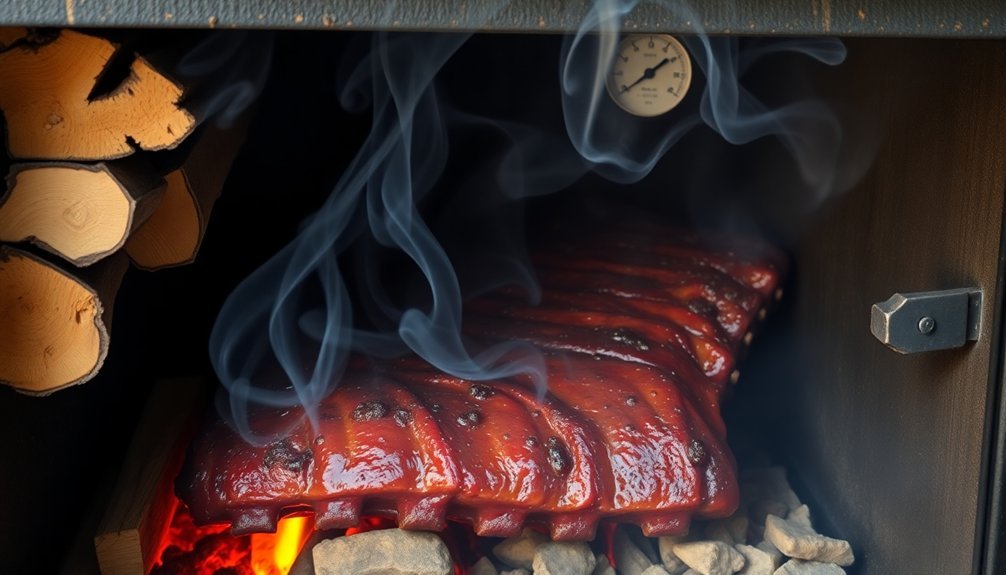
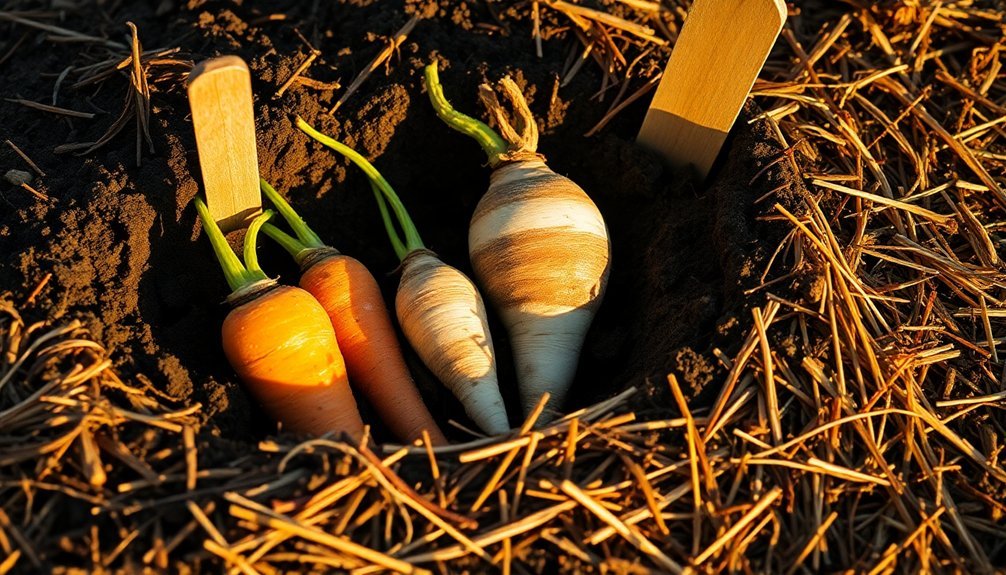
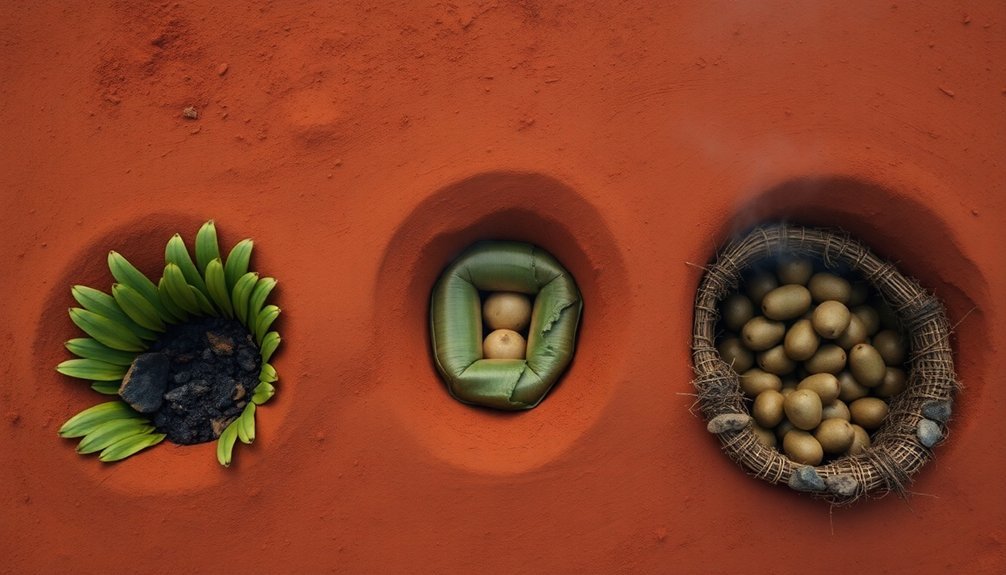
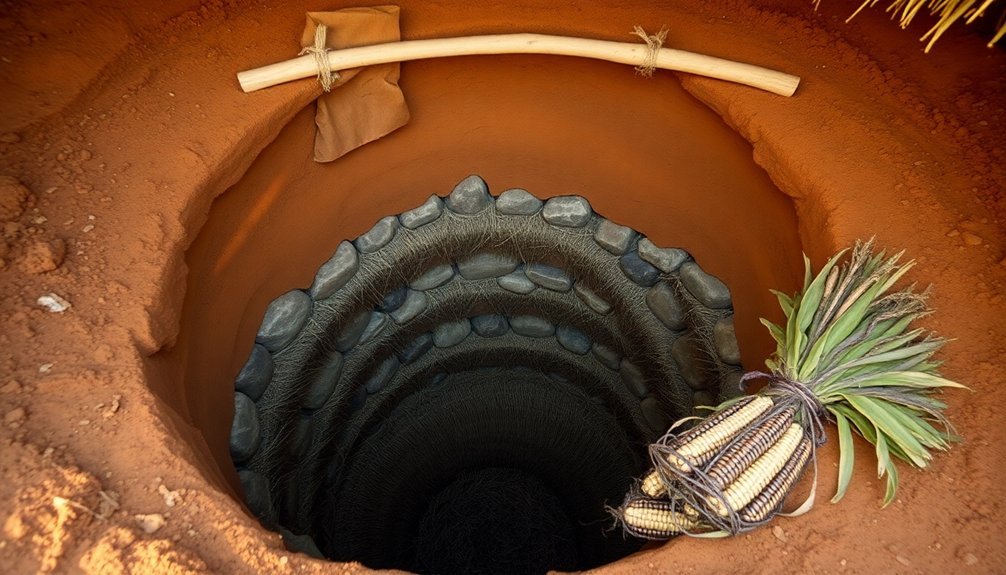
Leave a Reply